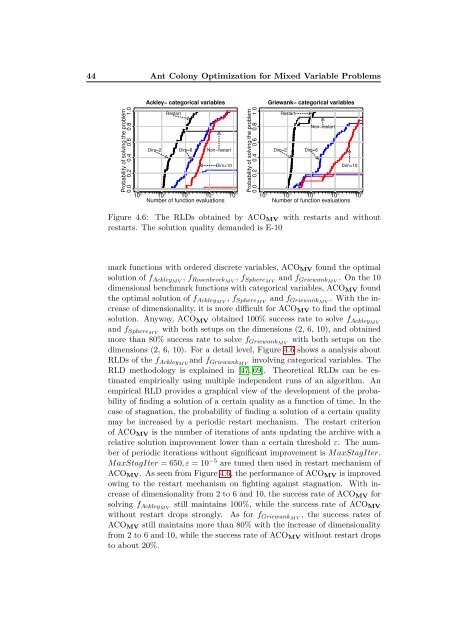Improved ant colony optimization algorithms for continuous ... - CoDE
Improved ant colony optimization algorithms for continuous ... - CoDE
Improved ant colony optimization algorithms for continuous ... - CoDE
You also want an ePaper? Increase the reach of your titles
YUMPU automatically turns print PDFs into web optimized ePapers that Google loves.
44 Ant Colony Optimization <strong>for</strong> Mixed Variable Problems<br />
Probability of solving the problem<br />
0.0 0.2 0.4 0.6 0.8 1.0<br />
10 2<br />
Ackley− categorical variables<br />
10 3<br />
Restart<br />
Dim=2 Dim=6<br />
10 4<br />
Non−restart<br />
10 5<br />
Dim=10<br />
Number of function evaluations<br />
10 6<br />
Probability of solving the problem<br />
0.0 0.2 0.4 0.6 0.8 1.0<br />
10 2<br />
Griewank− categorical variables<br />
Restart<br />
Dim=2 Dim=6<br />
10 3<br />
Non−restart<br />
10 4<br />
10 5<br />
Dim=10<br />
Number of function evaluations<br />
Figure 4.6: The RLDs obtained by ACOMV with restarts and without<br />
restarts. The solution quality demanded is E-10<br />
mark functions with ordered discrete variables, ACOMV found the optimal<br />
solution of fAckleyMV , fRosenbrockMV , fSphereMV and fGriewankMV . On the 10<br />
dimensional benchmark functions with categorical variables, ACOMV found<br />
the optimal solution of fAckleyMV , fSphereMV and fGriewankMV . With the increase<br />
of dimensionality, it is more difficult <strong>for</strong> ACOMV to find the optimal<br />
solution. Anyway, ACOMV obtained 100% success rate to solve fAckleyMV<br />
and fSphereMV with both setups on the dimensions (2, 6, 10), and obtained<br />
more than 80% success rate to solve fGriewankMV with both setups on the<br />
dimensions (2, 6, 10). For a detail level, Figure 4.6 shows a analysis about<br />
RLDs of the fAckleyMV and fGriewankMV involving categorical variables. The<br />
RLD methodology is explained in [47, 69]. Theoretical RLDs can be estimated<br />
empirically using multiple independent runs of an algorithm. An<br />
empirical RLD provides a graphical view of the development of the probability<br />
of finding a solution of a certain quality as a function of time. In the<br />
case of stagnation, the probability of finding a solution of a certain quality<br />
may be increased by a periodic restart mechanism. The restart criterion<br />
of ACOMV is the number of iterations of <strong>ant</strong>s updating the archive with a<br />
relative solution improvement lower than a certain threshold ε. The number<br />
of periodic iterations without signific<strong>ant</strong> improvement is MaxStagIter.<br />
MaxStagIter = 650, ε = 10−5 are tuned then used in restart mechanism of<br />
ACOMV. As seen from Figure 4.6, the per<strong>for</strong>mance of ACOMV is improved<br />
owing to the restart mechanism on fighting against stagnation. With increase<br />
of dimensionality from 2 to 6 and 10, the success rate of ACOMV <strong>for</strong><br />
solving fAckleyMV still maintains 100%, while the success rate of ACOMV<br />
without restart drops strongly. As <strong>for</strong> fGriewankMV , the success rates of<br />
ACOMV still maintains more than 80% with the increase of dimensionality<br />
from 2 to 6 and 10, while the success rate of ACOMV without restart drops<br />
to about 20%.<br />
10 6

















